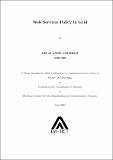| dc.description.abstract | Service-oriented computing enables service providers to publish their business functionalities in the form of abstract contracts, which can be discovered by service consumers based on open and standard protocols. Enterprise may be running a number of multiple business processes in parallel, which may require different services to fulfil the functionality.
There are number of factors that both service provider and service consumer should consider before they interact with each other. Web services standards are used for acquiring interoperability among services for large scale adoption of architecture. In Web service selection phase without the use of policy, a service consumer selects the Web service which matches the functional requirements. For satisfying non-functional requirements of a service consumer, policy is used in Web service selection phase. This thesis proposes an approach and architecture to select Web services based on WS-Policy in grid. Service selection depends on metadata and policy. There is a need for dynamic selection services based on runtime environment such as content (semantics), and contract (policy). This thesis proposes an approach and architecture for dynamic selection of services based on policy and semantic .To provide better search, query, composition, and management, there is a need for mechanism to group these services based on the requirements of clients and business processes. This thesis proposes context and location based approach for service grouping and group notification. Context and location provide powerful mechanism for the better search, query, grouping and group notification to the services, and it allows customization based on user preferences, role, and location to improve personalization. The thesis proposes context and location driven grid business process to aggregate information from multiple sources according to the preferences of clients. A policy based service grouping approach is used to aggregate services. For achieving location driven approach, this thesis develops virtual organization and for specifying preferences in virtual organization, a policy is used. | |

